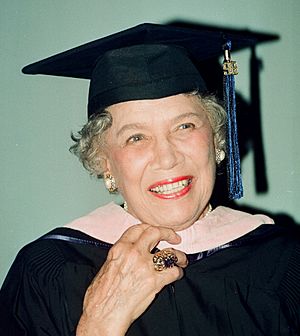Anne Brown facts for kids
Quick facts for kids
Anne Brown
|
|
|---|---|

Anne Brown receiving Peabody Award, 1998
|
|
| Born |
Annie Wiggins Brown
August 9, 1912 |
| Died | March 13, 2009 (aged 96) Oslo, Norway
|
Anne Brown (August 9, 1912 – March 13, 2009) was an American singer. She was a soprano, which is a high female singing voice. She became famous for playing the role of "Bess" in the original opera Porgy and Bess in 1935. The composer, George Gershwin, even changed the part of Bess to be a main character because of her.
Anne Brown also sang on the radio and in concerts. In 1948, she moved to Norway and later became a Norwegian citizen.
Contents
Early Life and Big Dreams (1912–1936)
Anne Brown, whose full name was Annie Wiggins Brown, was born in Baltimore, Maryland. Her father was a doctor. Her mother's family had a mix of backgrounds, including African-American, Cherokee Native American, and Scottish-Irish.
Growing up, Anne faced challenges because she was African-American. She was not allowed to attend a local Catholic elementary school. Later, she tried to get into the Peabody Institute for music, but they turned her down because of her race.
But Anne didn't give up! With encouragement from a friend, she applied to the Juilliard School in New York City. She was accepted at age 16, becoming the first African-American singer to study there. She worked hard and even won a special scholarship.
How Bess Became a Main Role
In 1933, while still at Juilliard, Anne heard that George Gershwin was writing an opera about African Americans. She wrote him a letter. This led to her being invited to sing for him. She sang classical songs and a spiritual called "A City Called Heaven." Gershwin was so impressed that he often asked her to sing parts of the opera as he wrote the music.
Because of Anne's amazing talent, the role of Bess grew. In the original book, Bess was a smaller character. But Gershwin made her one of the most important roles in the opera, especially for Anne.
Making History with Porgy and Bess
Anne Brown made history when she sang Bess for the very first time. This was at the world premiere of Porgy and Bess in Boston on September 30, 1935. The show then moved to New York City on October 10, 1935. Critics praised Anne's performance, calling it "a high point of interpretation."
After its run in New York, Porgy and Bess went on a tour across the United States in 1936. When the show reached Washington, D.C., the cast, led by another singer named Todd Duncan, protested against segregation. Segregation meant that Black people were not allowed to sit with white people in the theater.
Anne Brown bravely stood up. She said, "I will not sing... If my mother, my father, my friends, if black people cannot come hear me sing, then count me out." Her strong stand, along with the rest of the cast, convinced the theater management to allow everyone to sit together for the first time. This was a huge step forward, even though segregation returned after the show's final performance.
Later Life and Career: 1937–2009
After her success as Bess, Anne Brown continued to perform on Broadway. She also sang Bess in later revivals of Porgy and Bess. You can even hear her singing some of Bess's music in the 1945 movie Rhapsody in Blue, which was about George Gershwin's life.
Moving to Europe
From 1942 to 1948, Anne toured Europe as a concert singer. She decided to leave the United States because she continued to face racial prejudice. She once said, "Many things that I wanted as a young person for my career were denied to me because of my color." She felt that her singing was better received in Europe, especially when she sang music by European composers.
In 1948, Anne Brown moved to Oslo, Norway, and later became a Norwegian citizen. She married Thorleif Schjelderup, a famous skier. She had two daughters, Paula and Vaar Inga.
A New Path as a Teacher
Anne continued singing professionally into the 1950s. However, she had to stop performing regularly after 1955 due to problems with asthma. But this didn't stop her! She started a new career as a voice teacher. She taught many famous students, including actress Liv Ullmann and singer Karin Krog.
Anne also directed several operas in France and Norway. She was a special guest at the opening of the Oslo Opera House in 2008. She lived in Oslo until she passed away in 2009 at the age of 96. Her important papers and belongings are kept at the Amistad Research Center in New Orleans.
Awards
Anne Brown received several important awards for her contributions to music:
- In 1998, she was given the George Peabody Medal from the Peabody Institute. This was very special because it was the same institution that had rejected her due to her race 70 years earlier.
- In 1999, she was made an honorary citizen of Baltimore, her hometown.
- In 2000, she received Norway's Council of Cultures Honorary Award.

